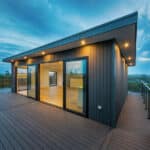The Pros of uPVC Wood Panels: A Comprehensive Overview
uPVC wood panels are a versatile building material known for their unique blend of aesthetics and durability. These panels combine the classic appearance of wood with the strength and resilience of uPVC (unplasticized polyvinyl chloride). In this article, we will delve into the many advantages that uPVC wood panels offer, making them an attractive choice for a wide range of architectural and design projects.
1. Aesthetic Appeal
One of the primary draws of uPVC wood panels is their aesthetic appeal. These panels closely mimic the natural grain patterns and textures of wood, offering a warm and inviting look. Whether used indoors for interior paneling or outdoors for cladding, uPVC panels add a timeless charm to any space.
2. Durability
Durability is a hallmark of uPVC. The combination of uPVC and wood results in a material that is resistant to environmental stressors. These panels do not rot, warp, or corrode when exposed to moisture, making them a reliable choice for outdoor applications like decking and siding.
3. Low Maintenance
Unlike traditional wood, uPVC panels are low maintenance. They do not require staining, sealing, or painting to maintain their appearance. Regular cleaning is typically sufficient to keep them looking pristine, saving time and money on upkeep.
4. Environmental Resilience
uPVCs are environmentally resilient. They can withstand exposure to UV rays without fading or deteriorating, making them suitable for outdoor installations where they remain vibrant and appealing over time.
5. Versatility
These panels are versatile in their applications. They are used in various projects, from interior paneling to exterior cladding, offering design flexibility and adaptability to different architectural styles.
6. UV Stability
The UV stability of uPVC wood panels ensures that they retain their color and finish even when subjected to harsh sunlight. This resistance to sun-induced damage is a significant advantage in maintaining their appearance.
7. Longevity
The combination of uPVC and wood results in a material with impressive longevity. uPVC wood panels can last for many years without deteriorating, providing a long-lasting solution for building projects.
Frequently Asked Questions
uPVC blend the appearance of wood with the resilience of uPVC (unplasticized polyvinyl chloride) to create a material that offers both aesthetic appeal and durability.
uPVC closely mimic the grain patterns and textures of natural wood, providing a warm and inviting appearance suitable for a wide range of design projects.
uPVC are resistant to rot, warping, and corrosion, making them ideal for outdoor applications such as decking and siding.
Unlike traditional wood, uPVC wood panels do not require staining, sealing, or painting. Regular cleaning is typically sufficient to maintain their appearance.
uPVC wood panels have UV stability, allowing them to retain their color and finish even in harsh sunlight, making them suitable for outdoor installations.
These panels are used in various projects, from interior paneling to exterior cladding, offering versatility and adaptability to different architectural styles.
The combination of uPVC and wood materials results in uPVC wood panels that can last for many years without deteriorating, providing a long-lasting solution for architectural projects.
Conclusion
uPVC wood panels offer a wide array of benefits, making them a favored choice for architects, designers, and builders. From their classic aesthetic appeal to their durability, low maintenance, and environmental resilience, uPVC wood panels are a reliable and versatile material for a broad spectrum of projects. Whether you’re designing an indoor space with a rustic touch or an outdoor deck, these panels offer the perfect combination of style and substance.












